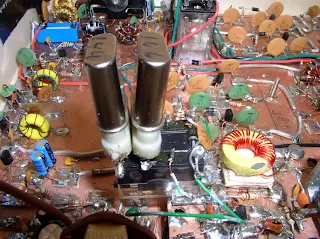Years ago I bought a Barebones Superhet from Dale Parfitt on E-bay. Several years after that, having forgotten who I bought it from, I was asking questions about how to get it working on 17 meters. Dale jumped in with some very helpful e-mails. It took us both a while to realize that I was working on the receiver that he had built. Dale is active in a really wide range of ham radio activities, everything from QRP to EME. Check out his homebrew projects here (I really like his Solid State Drake 2-B!) http://www.parelectronics.com/par-homebrew-projects.php
And his vintage projects here: http://www.parelectronics.com/vintage-radio-restoration.php
And here's what Dale has been doing with the Moon (that's his 15 foot dish in the picture):
And his vintage projects here: http://www.parelectronics.com/vintage-radio-restoration.php
And here's what Dale has been doing with the Moon (that's his 15 foot dish in the picture):
Hi Bill,
I thought of you today when I won a Bare Bones Barbados RX on
eBay for $5. I am going to team it with a DDS VFO and a matching
TX.Some parts are apparently missing, but i have a huge junk box
and also know how to order from Mouser should the junk box fail me.
Right now I am putting my solid state 650W 1296MHz EME amp ,
Power Supply, meters etc. in its waterproof cabinet so I can mount it right at the dish
and not incur any feedline losses.
1296 is probably the best EME band. Power is getting easier and
easier to acquire (although solid state is around $5/watt), dishes are fairly
easy to acquire or build and perhaps most importantly, we all use circular
polarity feeds with no relays/hybrids. Activity weekend can sound like 20M, with
a number of stations just ragchewing on CW and SSB.
73,
Dale W4OPfor PAR Electronics, Inc.
http://www.parelectronics.com
Our book: "SolderSmoke -- Global Adventures in Wireless Electronics" http://soldersmoke.com/book.htm Our coffee mugs, T-Shirts, bumper stickers: http://www.cafepress.com/SolderSmoke Our Book Store: http://astore.amazon.com/contracross-20












